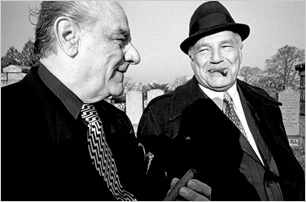
Kingdom Kim's Culinary OutpostsInside the bizarre world of Asia's North Korean restaurant chain.
Posted Monday, March 22, 2010, at 12:09 PM ET Packed for dinner each night, the Pyongyang restaurant in the heart of Cambodia's capital, Phnom Penh, is as famous for its kimchi as for its troupe of talented Korean waitresses, who perform an elaborate floor show for patrons. But Pyongyang is no ordinary Korean mess hall. The operation is run by the North Korean government, part of a chain of dozens of eateries—stretching from northern China to Thailand—that funnels much-needed foreign exchange into the state coffers in Pyongyang. While a visit to the reclusive Democratic People's Republic of Korea is next to impossible for most, Pyongyang offers casual diners a window into Kingdom Kim, an elaborate combination of food and culture from north of the 38th parallel.
Packed for dinner each night, the Pyongyang restaurant in the heart of Cambodia's capital, Phnom Penh, is as famous for its kimchi as for its troupe of talented Korean waitresses, who perform an elaborate floor show for patrons. But Pyongyang is no ordinary Korean mess hall. The operation is run by the North Korean government, part of a chain of dozens of eateries—stretching from northern China to Thailand—that funnels much-needed foreign exchange into the state coffers in Pyongyang. While a visit to the reclusive Democratic People's Republic of Korea is next to impossible for most, Pyongyang offers casual diners a window into Kingdom Kim, an elaborate combination of food and culture from north of the 38th parallel.
Visitors to the restaurant are ushered into an air-conditioned, flood-lit hall filled with dozens of glass-topped tables. Unlike North Korea proper, which is wracked by economic sanctions and constant famines, the food here is fresh and abundant. The menu features specialties such as Pyongyang "cold noodle" (served encrusted with ice), barbecued cuttlefish, stringy dangogi (dog meat) soup, and countless variations on the kimchi theme, all served with glutinous white rice. Also available for sale are a series of North Korean products, including ginseng wine and some nameless bear "product" promised to increase sexual virility. All carry hefty price tags in U.S. dollars, since the Cambodian riel is not convertible outside the country.
In addition to the food, the main attraction is the group of pretty North Korean-born waitresses, who perform music and dance routines complete with tightly synchronized choreography reminiscent of North Korea's annual Mass Games. Donning traditional chima jogoiri dresses and pasted-on smiles, the pretty young women serenade diners with violins, guitars, synthesized karaoke, and Korean pansori music. The predominantly South Korean clientele claps and cheers, requesting reverb-drenched renditions of Korean pop classics.
Aside from small North Korean flags pinned to the waitresses' blouses, the restaurant is surprisingly free from overt propagandizing. Instead of paeans to the Great Leader and his revolutionary juche ideology, the walls are adorned with a series of monumental landscape paintings. One crashing seascape, rendered in an apocalyptic palette of blues, greens, and reds, recalls the painting used as a backdrop to the official photo of Kim Jong-il and Bill Clinton that was taken during Clinton's visit to Pyongyang in August. The cold flood-lighting and no-camera policy (often violated on the sly by curious Western expats) also lend an Orwellian tinge to an evening at Pyongyang, though the authoritarian mood is often broken by the sound of drunken South Korean businessmen warbling their way through the restaurant's thick karaoke catalog.
North Korean government-run restaurants have existed for years in the regions of China adjacent to the DPRK's northern border, but the 21st century has seen an expansion of the business into other parts of Asia. In 2002, the first Southeast Asian branch of Pyongyang opened in the Cambodian tourist hub of Siem Reap, and it became an immediate hit with South Korean tour groups visiting the nearby temples of Angkor. The success of the restaurant, reportedly opened by Ho Dae-sik, the local representative of the DPRK-aligned International Taekwondo Federation, led to the opening of the Phnom Penh branch in 2003. This was followed by more elaborate establishments in Bangkok and the popular Thai beach resort of Pattaya, as well as a small branch in the Laotian capital, Vientiane.
Little is known of how the restaurants operate, but experts say they are closely linked with other overseas operations run by the reclusive regime in Pyongyang. Bertil Lintner, author of Great Leader, Dear Leader: Demystifying North Korean Under the Kim Clan, says that in the early 1990s, North Korea was hit by a severe economic crisis caused by the disruption in trading ties with its former Communist allies. At that time, both the Soviet Union and China began to demand that Pyongyang pay for imports in hard currency rather than barter goods, forcing it to open "capitalist" foreign ventures to make up funding shortfalls. He says the restaurants are part of this chain of trading companies controlled by Bureau 39, the "money making" (and money-laundering) arm of the Korean Workers' Party.
"The restaurants are used to earn additional money for the government in Pyongyang—at the same time as they were suspected of laundering proceeds from North Korea's more unsavory commercial activities," he says. "Restaurants and other cash-intensive enterprises are commonly used as conduits for wads of bills, which banks otherwise would not accept as deposits."
on the Fray
-
Health care bill will require new restaurant menus that include calorie counts http://bit.ly/cd7ZTF
-
Become a fan of Slate on Facebook http://bit.ly/4EGWiY Follow us on Google Buzz http://bit.ly/aanSOz
-
Haliburton withdraws appeal in Jamie Leigh Jones rape case http://bit.ly/dB9Dwh
 Shafer: What Ross Douthat Overlooks About Conspiracy Theorists
Shafer: What Ross Douthat Overlooks About Conspiracy Theorists Why Do Investors Keep Making Bad Bets Against Obama?
Why Do Investors Keep Making Bad Bets Against Obama?  Strange YouTube Trend: The Girls Who Want To Show You the Clothes They Just Bought
Strange YouTube Trend: The Girls Who Want To Show You the Clothes They Just Bought Slate's Sports Experts Size Up the Sweet 16
Slate's Sports Experts Size Up the Sweet 16 Companies Get Paid To Use Less Energy. Why Not Homeowners Like Me?
Companies Get Paid To Use Less Energy. Why Not Homeowners Like Me? Obama's Bold Plan To Fix America's Lousy Internet Connection
Obama's Bold Plan To Fix America's Lousy Internet Connection














